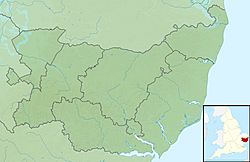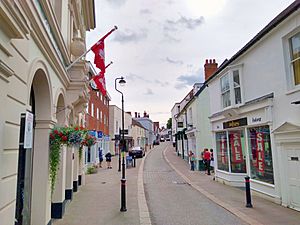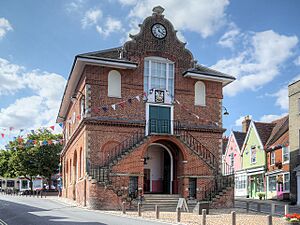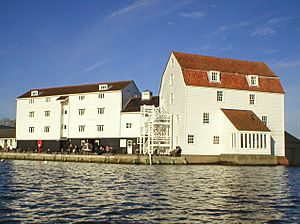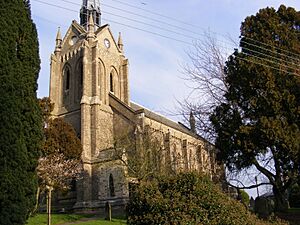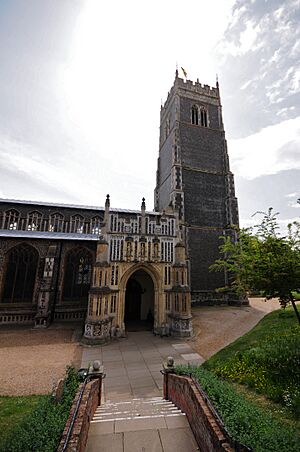Woodbridge, Suffolk facts for kids
Quick facts for kids
Woodbridge
|
||
|---|---|---|
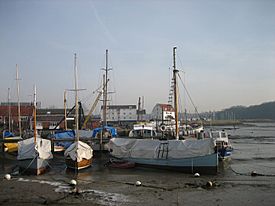
The harbour, with Woodbridge Tide Mill in the background
|
||
|
||
| Sovereign state | United Kingdom | |
| Constituent Country | England | |
| Region | East Anglia | |
| County | Suffolk | |
| Population
(2011)
|
||
| • Total | 7,749 | |
| • Estimate
(2020)
|
8,244 | |
| (2011 Census) | ||
| Postcode |
IP12, IP13
|
|
| Area code(s) | 01394 | |
Woodbridge is a port town in Suffolk, England. It is located about 8 miles (13 km) up the River Deben from the sea. The town is 7 miles (11 km) north-east of Ipswich and about 74 miles (119 km) north-east of London. In 2011, Woodbridge had a population of 7,749 people.
Woodbridge is famous for its nearby Anglo-Saxon archaeological sites. These include the amazing Sutton Hoo burial ship. The town is also well known for its busy boating harbour and a special tide mill on the River Deben. This area is part of the beautiful Suffolk & Essex Coast & Heaths National Landscape. Many festivals take place here. Woodbridge has been called a "gem in Suffolk's crown" and even the best place to live in the East of England.
Contents
- What's in a Name? The Etymology of Woodbridge
- Woodbridge Through Time: History and Heritage
- How Woodbridge is Governed
- Education and the Arts in Woodbridge
- Local Media
- Sports and Fun Activities
- Places of Worship
- Climate in Woodbridge
- Famous People from Woodbridge
- Twin Town
- Freedom of the Town
- See also
What's in a Name? The Etymology of Woodbridge
Historians have different ideas about where the name Woodbridge comes from.
Old English Meanings
The Dictionary of British Placenames (2003) suggests the name comes from two Old English words: wudu (meaning wood) and brycg (meaning bridge). However, the Sutton Hoo Society's magazine Saxon (1988) points out some problems with this idea. There isn't a good place for a bridge at Woodbridge itself. The nearest place to cross the river was miles upstream. Also, an Anglo-Saxon bridge being made of wood wouldn't have been special enough to name a town after.
Other Name Ideas
Saxon suggests the name might come from odde (meaning promontory or cape) and breg (meaning king). This is interesting because of the nearby Sutton Hoo, where a king was buried. Another idea is bryg, which means quay (a landing place for boats).
The Suffolk Traveller (1764) thought the name came from a bridge over a sunken path. This path led from Woodbridge Market Place to Ipswich. But a local church leader, Rev. Thomas Carthew, disagreed. He said that bridge was too new to be the source of the town's name. He suggested the name came from Oden or Woden (the god Odin) and Burgh, Bury, or Brigg (meaning town).
Woodbridge Through Time: History and Heritage
Evidence shows people have lived in the Woodbridge area since the Stone Age (around 2500–1700 BCE). A special ritual site was found during excavations for a wind farm. The Romans also lived here for 300 years after Queen Boudica's rebellion in 59 CE, but not much Roman evidence remains.
Anglo-Saxon Times
After the Romans left in 410 CE, many Anglo-Saxons settled here. They gave their name to the region, East Anglia.
King Rædwald of East Anglia was a very powerful king in England in the early 7th century. He died around 624 CE. Many believe he was buried at Sutton Hoo, which is across the River Deben from Woodbridge. The burial ship found there was 89 feet (27 meters) long.
In 1939, amazing treasures were found at Sutton Hoo. These were the richest finds ever in Britain! The original treasures are now in the British Museum in London. However, you can see copies of some items and learn about the finds at the Woodbridge Museum. The National Trust has also built a visitor centre at the Sutton Hoo site.
Medieval Woodbridge
The first record of Woodbridge as a town is from the mid-10th century. It was given to St Aethelwold, a bishop, in 970. The Domesday Book of 1086 described Woodbridge as a large settlement with 35 households. Much of Woodbridge was later given to the powerful Bigod family. They built the castle at Framlingham.
Woodbridge has been a centre for building boats, making ropes, and creating sails since the Middle Ages. Even King Edward III and Sir Francis Drake had warships built here. The town suffered during the plague in 1349. But it recovered and built a new church, St Mary's. This church was made of limestone and decorated with flint.
Tudor Times and Beyond
In 1534, the local priory (a type of monastery) accepted King Henry VIII as the head of the Church. Three years later, the priory was closed down.
During the time of Queen Mary I, some people were executed for their religious beliefs. Later, under Queen Elizabeth I, Woodbridge's industries grew. These included weaving, sail-cloth making, rope-making, and salt making. The wool trade also did well. The port became bigger, and shipbuilding and timber trading became very profitable. A customs house was set up in 1589 to collect taxes on goods.
Woodbridge has many old buildings from the Tudor, Georgian, Regency, and Victorian periods. It also has a working tide mill. This is one of only two still working in the UK! The mill was first recorded in 1170. In 1564, Queen Elizabeth I gave the mill to Thomas Seckford. He later founded Woodbridge School and homes for the poor. Two windmills also remain: Buttrum's Mill (which you can visit) and Tricker's Mill.
In 1943, the Royal Air Force (RAF) built a military airfield east of Woodbridge. This base, RAF Woodbridge, was used by the United States Air Force until 1993.
How Woodbridge is Governed
Woodbridge is part of the East Suffolk district in Suffolk. It has a civil parish and its own town council. The council is based at Woodbridge Shire Hall. It has a mayor and 16 councillors. These councillors are elected from four different areas of the town.
The town is currently represented by the Labour Member of Parliament (MP) Jenny Riddell-Carpenter. She represents the Suffolk Coastal area in the UK Parliament. The county councillor for Woodbridge is Caroline Page, from the Liberal Democrats.
Education and the Arts in Woodbridge
Woodbridge has several schools for young people.
Local Schools
There are state-funded primary schools like Woodbridge Primary School, Kyson Primary School, and St Mary's Church of England Primary School. For older students, there is Farlingaye High School. Woodbridge also has an independent school called Woodbridge School. It has junior and senior sections and offers boarding for students who live there.
Arts and Culture
The town has a community brass band called the Excelsior. It was started in 1846, making it the oldest in East Anglia. Woodbridge also has a local radio station.
The town has a two-hectare (5-acre) park with walls. Other interesting natural areas include the Quaker Burial Ground and Fen Meadow. This is a 2.67-hectare (6.6-acre) area of grassland that is managed in a traditional way.
Local Media
For local news and TV shows, people in Woodbridge can watch BBC East and ITV Anglia. TV signals come from the Sudbury TV transmitter and a local relay.
Local radio stations include BBC Radio Suffolk, Heart East, Greatest Hits Radio Ipswich & Suffolk, Nation Radio Suffolk, and Ipswich Community Radio. Ipswich Community Radio is based in nearby Ipswich.
The local newspaper that serves the town is the Ipswich Star.
Sports and Fun Activities
Woodbridge has a Non-League football club called Woodbridge Town F.C.. They play their games at Notcutts Park.
There are many clubs and groups in Woodbridge for different sports and hobbies. These include:
- Football
- Badminton
- Birdwatching
- Bowls
- Cricket
- Cruising
- Netball
- Road running
- Rowing (with Deben Rowing Club)
- Rugby football
- Swimming
- Tennis
- Golf (Woodbridge Golf Club and Ufford Park)
- Yachting (with Deben Yacht Club)
- Archery
The town's Deben Leisure Centre and swimming pool were updated in 2017–2018. They now offer more services to the community.
Places of Worship
Woodbridge has several churches and places of worship.
Churches of England
The two Church of England churches are the medieval St Mary's on Market Hill and the Victorian St John's on St John's Hill.
Other Denominations
The Woodbridge Quay Church is on Quay Street. It was formed in 2006 when the town's Baptist and United Reformed congregations joined together. It is connected to the Baptist Union of Great Britain and the Evangelical Alliance.
You can also find a Methodist Church on St John's Street and a Salvation Army hall on New Street. The Roman Catholic Church of St Thomas of Canterbury is also on St John's Street. This church shares a parish with Framlingham.
The Woodbridge Quaker Meeting gathers weekly at Woodbridge Shire Hall. Avenue Evangelical Church, located on the edge of Woodbridge, is part of the Fellowship of Independent Evangelical Churches.
Climate in Woodbridge
Woodbridge has a warmer summer climate than usual for Britain. It is also very dry compared to many other parts of the UK. This information is based on averages from 1991–2020.
| Climate data for RAF Bentwaters 26m amsl (1991–2020) | |||||||||||||
|---|---|---|---|---|---|---|---|---|---|---|---|---|---|
| Month | Jan | Feb | Mar | Apr | May | Jun | Jul | Aug | Sep | Oct | Nov | Dec | Year |
| Mean daily maximum °C (°F) | 7.8 (46.0) |
5.8 (42.4) |
10.2 (50.4) |
11.2 (52.2) |
15.3 (59.5) |
17.7 (63.9) |
21.5 (70.7) |
22.6 (72.7) |
19.3 (66.7) |
12.9 (55.2) |
10.6 (51.1) |
7.3 (45.1) |
13.5 (56.3) |
| Daily mean °C (°F) | 6.0 (42.8) |
4.0 (39.2) |
7.7 (45.9) |
8.3 (46.9) |
12.2 (54.0) |
14.4 (57.9) |
18.4 (65.1) |
19.1 (66.4) |
15.9 (60.6) |
10.5 (50.9) |
8.3 (46.9) |
5.4 (41.7) |
10.9 (51.5) |
| Mean daily minimum °C (°F) | 4.1 (39.4) |
2.2 (36.0) |
5.2 (41.4) |
5.3 (41.5) |
9.1 (48.4) |
11.1 (52.0) |
15.4 (59.7) |
15.5 (59.9) |
12.5 (54.5) |
8.0 (46.4) |
6.1 (43.0) |
3.4 (38.1) |
8.2 (46.7) |
| Average rainfall mm (inches) | 43.7 (1.72) |
46.4 (1.83) |
36.9 (1.45) |
39.4 (1.55) |
48.0 (1.89) |
45.8 (1.80) |
23.1 (0.91) |
15.2 (0.60) |
61.3 (2.41) |
20.1 (0.79) |
65.5 (2.58) |
38.3 (1.51) |
483.7 (19.04) |
| Average rainy days (≥ 1.0 mm) | 8.6 | 8.4 | 9.3 | 8.6 | 6.8 | 10.6 | 5.4 | 5.0 | 5.5 | 10.1 | 13.5 | 8.3 | 100.1 |
| Source: Meteoclimat | |||||||||||||
Famous People from Woodbridge
Many interesting people have connections to Woodbridge.
Writers and Artists
- Edward FitzGerald and Anne Knight, both writers, were born in Woodbridge.
- The writer Bernard Barton lived in the town later in his life.
- The painter Thomas Churchyard was also from Woodbridge.
Musicians and Actors
- Musicians Nate James and Charlie Simpson have lived here.
- Actors Brian Capron and Nicholas Pandolfi are also connected to the town.
- Musicians Brian Eno and Brinsley Schwarz were born in Woodbridge.
- The actor Gavin Lee was born here.
Other Notable Residents
- Ian Jacob was the Director-General of the BBC.
- John Clarkson was an abolitionist, meaning he worked to end slavery.
- Football manager Roy Keane has lived in Woodbridge.
- Thomas Seckford was an important official in the court of Queen Elizabeth I.
- The clockmaker John Calver lived in the town.
- Vernon Lewis, a footballer, was born here.
- The composer Christopher Wright (1954–2024) and his wife, violinist Ruth Dickins (1958–2009), lived in Woodbridge.
Twin Town
Since 1973, Woodbridge has been twinned with Mussidan. Mussidan is a town in the Dordogne region of south-west France. This means the two towns have a special friendship and cultural exchange.
Freedom of the Town
The "Freedom of the Town" is a special honour given to people or military groups. It means they have a close connection to Woodbridge.
Military Units Honoured
- 23 Parachute Engineer Regiment: Received the honour in 2006.
- The Royal Air Force: Received the honour on June 11, 2016.
- The Royal British Legion (Woodbridge Branch): Received the honour on June 11, 2016.
|
See also
 In Spanish: Woodbridge (Suffolk) para niños
In Spanish: Woodbridge (Suffolk) para niños



